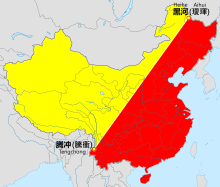Heihe Tengchong Line
The Heihe-Tengchong line ( Chinese 黑河 - 騰沖 線 / 黑河 - 腾冲 线 , Pinyin Hēihé-Téngchōng xiàn ), also called Aihui-Tengchong line , is an imaginary line that divides the area of China into two roughly equal parts.
It is drawn diagonally across China from Heihe ( 黑河 , Hēihé ) (in the Heilongjiang Province ) to Tengchong ( 騰衝 / 腾冲 , Téngchōng ) (in the Yunnan Province ) and was already named in 1935 by the Chinese population geographer Hu Huanyong as " geo-demographic demarcation line ”.
The line divides the territory of China as follows:
- west of the line: 57% of the area, but only 4% of the population (1935);
- east of the line: 43% of the area but 96% of the population (1935).
Despite extensive migration towards the southeast, this distribution has hardly changed over the decades:
- west of the line: 57% of the area, but only 6% of the population (2015);
- east of the line: 43% of the area but 94% of the population (2015).
This geodemography is determined by natural factors: while the east of China is characterized by four large, densely populated alluvial plains with a continental climate , the west and north-west of the country have a pronounced high mountain character with plateaus in between . West China , together with the Inner Mongolia the driest part of the country, for its pronounced desert climate the Gobi and the Taklamakan stand.
The percentage distribution of the Chinese population to the left and right of the Heihe-Tengchong line has remained more or less constant after more than 80 years: The 1990 census showed a ratio of 5.7% of the population west to 94.3% of the population east of the line. In the 2000 census, the ratio was 9.2% to 90.8%. Thus, in the east, the population fell from 1,182 to 1,151 million between 1990 and 2000, while in the western part it rose from 65 to 116 million, and thus the overall increase in the Chinese population took place only in the western part.
Web links
- Numerical Simulation of Population Distribution in China (PDF file; 998 kB)
- Population development in China (Prof. Dr. Wolfgang Taubmann, University of Bremen )
Individual evidence
- ↑ a b http://dtcaijing.baijia.baidu.com/article/473345
- ^ Barry Naughton: The Chinese Economy: Transitions and Growth. MIT Press, 2007, pp. 18-19.
